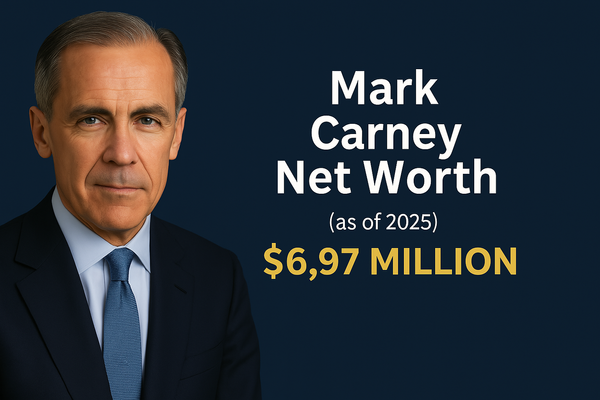Breaking: Poilievre Vows Complete Reversal of Capital Gains Tax Hike

Conservative Leader Pierre Poilievre's bold announcement to reverse the federal government's capital gains tax increase has sent ripples through Canada's political and economic landscape. Specifically, this dramatic policy shift promises to undo recent tax changes that increased capital gains inclusion rates. The announcement comes at a crucial time when Canadian investors and businesses grapple with economic uncertainties.
Additionally, this tax reversal pledge represents one of the most significant economic policy proposals in recent Canadian political history. The comprehensive plan not only challenges the current government's fiscal approach but also raises important questions about implementation, provincial coordination, and broader economic impacts. From job creation projections to investment climate implications, the proposed reversal could fundamentally reshape Canada's tax framework.
Breaking Down Poilievre's Tax Reversal Promise
In a significant policy declaration, Pierre Poilievre outlined his plan to eliminate the Liberal government's controversial capital gains tax changes. The Conservative leader's announcement focuses on reversing the increase in the inclusion rate, which jumped from one-half to two-thirds for capital gains above $250,000 for individuals and all gains for corporations and trusts [1].
Key elements of the announcement
The reversal strategy encompasses several critical components:
- Complete elimination of the increased inclusion rate
- Protection of small business interests
- Focus on maintaining investment stability
- Prevention of job losses, estimated at 414,000 positions [2]
Furthermore, the Conservative finance critic has challenged the legitimacy of collecting the increased rate, arguing it lacks proper parliamentary approval [1].
Political timing and context
The announcement arrives at a crucial juncture, as Parliament remains prorogued and the Canada Revenue Agency continues collecting the higher rate through a ways and means motion [1]. Meanwhile, the Canadian Chamber of Commerce has labeled this implementation "inappropriate and unprecedented" without proper legislative backing [1].
Business community reactions have been notably supportive:
- OMERS Ventures founder
- Shopify president
- Canadian Council of Innovators [3]
Trump tariff connection
Consequently, Poilievre has positioned this tax reversal as part of a broader economic defense strategy against Donald Trump's threatened tariffs [4]. The Conservative leader emphasizes that Canada "cannot afford economically destructive Liberal taxes" during this period of international trade uncertainty [2].
However, the plan faces scrutiny regarding revenue replacement, as the capital gains changes were projected to generate $19.40 billion annually [2]. The Conservative leader proposes offsetting these losses through "slashing corporate welfare" and eliminating subsidies to large businesses [3].
Economic Impact Analysis
Recent economic analysis reveals significant concerns about the impact of capital gains tax changes on Canada's economy. Economists project substantial economic consequences if the current tax structure remains unchanged.
Job loss projections and critique
According to the C.D. Howe Institute, the increased capital gains inclusion rate could lead to 414,000 job losses, potentially raising unemployment from 1.5 to 1.9 million Canadian workers [5]. Certainly, this projection has sparked debate among policy experts and business leaders.
The Canadian Federation of Independent Business reports that 72% of small business members believe the proposed capital gains tax will harm the investment climate and growth [6]. Particularly concerning is the timing, as economists note that per capita GDP is currently at concerning levels [7].
Investment climate implications
The investment landscape faces several challenges:
- Reduced attractiveness of Canadian investments
- Higher cost of capital for businesses
- Suppressed equity values
- Decreased domestic business stability [7]
Evidently, the tax changes could significantly affect Canadian investors who typically maintain substantial equity in local firms [7]. Accordingly, this shift might force businesses to seek alternative funding sources or relocate investments offshore [8].
GDP and productivity effects
The economic impact projections paint a concerning picture:
- Capital stock reduction of $127 billion [5]
- GDP decline of approximately $90 billion [5]
- Real per capita GDP decrease of 3% [5]
Bank of Canada Deputy Governor Carolyn Rogers has labeled Canada's record of poor productivity growth an "emergency," emphasizing the urgent need for increased business investment [9]. Furthermore, economists warn that raising capital gains taxes could discourage savings, a key driver of business investment, which has already declined in six of the last seven quarters [9].
The investment community particularly emphasizes that less after-tax reward will likely discourage risk-taking and investment, potentially worsening Canada's existing productivity challenges [9]. Significantly, the country continues to lag behind competitors in both productivity and GDP growth, indicating that Canadians are becoming collectively poorer while working harder to maintain their current standard of living [9].
Implementation Challenges
The implementation of capital gains tax changes faces substantial administrative hurdles, primarily due to Parliament's prorogation until March 24, 2025 [10]. The Canada Revenue Agency (CRA) continues to enforce these modifications despite lacking formal legislative approval, creating a complex landscape for taxpayers and administrators alike.
Tax filing complications
The new tax framework introduces several filing challenges for businesses and individuals:
- Extensive documentation requirements for compliance
- Overlapping reporting obligations across multiple forms
- Complex calculations for transitional periods
- Unclear guidance on implementation procedures [11]
Moreover, taxpayers must spend considerable time and resources on compliance, even in cases where no taxable income exists [11]. The administrative complexity manifests through lengthy forms, incomplete guidance, and irregular deadlines [11].
CRA administration issues
The CRA faces mounting pressure as it manages an expanding portfolio of responsibilities. Essentially, the agency now administers at least 135 social and economic benefit programs for federal and provincial governments [12]. This expanded mandate has led to several operational challenges:
- Overextended resources affecting core services
- Difficulties in providing clear guidance
- Increased complexity in tax administration [11]
Subsequently, many organizations lack sufficient internal infrastructure to understand and meet their new compliance obligations [13]. The constant changes have a compounding negative impact on Canada's business landscape, as new rules are introduced rapidly without clear guidance on their interaction with existing legislation [14].
Transition period concerns
The transition period introduces notably complex rules for tax years straddling June 25, 2024 [15]. Taxpayers must separately identify:
- Capital gains and losses realized before June 25, 2024
- Capital gains and losses realized on or after June 25, 2024 [15]
Ultimately, the Canadian Federation of Independent Business warns that this uncertainty period could extend for "a year or two," creating unfair conditions for their members [16]. The situation is further complicated by the CRA's push toward digital services, which may create additional barriers for vulnerable populations and those with limited digital access [12].
Business Community Response
The Canadian business community has responded vigorously to the proposed capital gains tax changes, with industry associations and business leaders expressing serious concerns about economic stability. The Canadian Taxpayers Federation, alongside other prominent business organizations, has voiced strong support for Poilievre's promise to reverse the tax increase [17].
Industry sector reactions
Industry associations have identified several pressing concerns:
- Increased compliance costs for businesses
- Greater uncertainty in tax planning
- Reduced competitiveness in global markets
- Potential deterrence of entrepreneurship
Fasken Martineau DuMoulin LLP reports that the uncertainty surrounding these measures has already had a "serious" impact on taxpayers [18]. Indeed, the Canadian Chamber of Commerce has labeled the implementation "inappropriate and unprecedented" without proper legislative backing.
Investment community feedback
The investment sector's response has been notably critical, with the Investment Industry Association of Canada (IIAC) calling for a comprehensive examination of the federal tax system. Essentially, the C.D. Howe Institute projects that the proposed tax changes would result in a capital stock decline of $127 billion [18].
Jack Mintz, president of the C.D. Howe Institute, emphasizes that "this would not just be a tax on the wealthy" [18]. Rather, middle-income Canadians would bear substantial impacts, with economic costs affecting the entire economy. The Council of Canadian Innovators has gathered more than 1,000 signatures from business leaders opposing the tax change [2].
Small business implications
Small business owners face unique challenges under the current tax proposal. Dennis Darby, president of Canadian Manufacturers & Exporters, states that the changes send the wrong message to Canadian industries [2]. Altogether, the impact on small businesses includes:
- Increased administrative burdens
- Higher compliance costs
- Reduced investment capacity
- Limited growth opportunities
The Canadian Federation of Independent Business reports that many members have expressed concerns about maintaining competitiveness [3]. Markedly, industry associations argue that increasingly complicated tax rules are discouraging entrepreneurship and hampering growth [3].
The Canadian Entrepreneurs' Incentive, introduced as a potential offset, offers some relief by reducing the capital gains inclusion rate to 33% on a lifetime maximum of $2 million [2]. Nonetheless, business groups maintain that this measure inadequately addresses broader concerns about economic growth and investment stability.
Provincial Revenue Implications
The provincial implications of reversing the capital gains tax increase extend far beyond federal coffers, as Canada's provinces face substantial revenue adjustments. Provincial governments must now navigate complex fiscal scenarios while maintaining essential public services.
Impact on provincial budgets
Ontario and Quebec, Canada's largest provinces, anticipate significant revenue changes from the capital gains tax modifications. Ontario projects revenue of CAD 900 million in personal income taxes and CAD 2.4 billion in corporate taxes between 2024-2025 and 2026-2027 fiscal years [19]. Likewise, Quebec expects a CAD 2.5 billion windfall over five fiscal years, with nearly CAD 1 billion allocated to the 2024-2025 fiscal year [19].
The federal government estimates that increasing the inclusion rate would generate substantial new revenue for provincial and territorial governments, equivalent to up to 60% of the new federal revenue [20]. Primarily, these funds were intended for:
- Housing development initiatives
- Healthcare system improvements
- Educational infrastructure
- Childcare programs
Federal-provincial tax coordination
The tax collection agreements (TCAs) between federal and provincial governments form the backbone of Canada's fiscal framework. Essentially, these agreements permit participating governments to engage in specified collection and enforcement activities [21]. In effect, the current system faces several coordination challenges:
Coordination Aspect | Impact Area |
|---|---|
Revenue Sharing | Provincial budget planning |
Tax Administration | Collection efficiency |
Policy Alignment | Implementation timeline |
Fiscal Autonomy | Provincial decision-making |
The federal government maintains responsibility for collecting and administering income taxes for provinces party to TCAs, whereas provinces must preserve similarity between provincial and federal income tax systems [22]. As opposed to creating separate provincial tax administrations, this arrangement offers efficiency benefits, although it limits provincial fiscal autonomy.
Alternative revenue sources
As provinces anticipate potential revenue gaps, they must explore alternative funding mechanisms. The provincial governments can increase revenues through improved agricultural income taxation, which simulations indicate could generate additional provincial revenues of around one percent of GDP [4]. Furthermore, provincial authorities have opportunities to enhance land taxation, potentially generating up to two percent of GDP in revenues through:
- Establishing reliable land ownership records
- Harmonizing valuation systems
- Increasing property tax rates
- Improving policy frameworks for peri-urban settlements
Quebec Finance Minister Eric Girard indicates that capital gains revenue already collected could remain in government coffers, even if future changes occur [19]. In general, provinces must balance the need for revenue generation with maintaining competitive tax environments that attract investment and support economic growth.
The coordination between related authorities, such as provincial-federal revenue authorities, or between revenue and expenditure authorities, represents a crucial step forward in managing these transitions [4]. Analogous to other federal systems, Canadian provinces must adapt their revenue strategies while maintaining essential public services and fiscal stability.
Conclusion
Poilievre's pledge to reverse capital gains tax changes represents a pivotal moment in Canadian fiscal policy. Economic projections certainly paint a concerning picture, with potential job losses reaching 414,000 positions and GDP declining by $90 billion. These numbers highlight significant stakes for Canadian businesses and investors.
The business community stands united against current tax changes, citing reduced competitiveness and investment deterrence. Small business owners face particular challenges, as increased administrative burdens compound their existing operational pressures. Provincial governments must also prepare for substantial revenue adjustments, with Ontario and Quebec anticipating multi-billion-dollar impacts on their budgets.
Implementation hurdles persist through Parliament's prorogation and CRA administrative complexities. Therefore, any tax policy changes require careful consideration of practical execution challenges alongside theoretical benefits. Above all, Canada's economic future hangs in balance as policymakers weigh competing priorities of revenue generation, business growth, and international competitiveness.
The proposed reversal could reshape Canada's investment landscape for years ahead. As a result, stakeholders across government, business, and provincial authorities must collaborate effectively to ensure stable economic growth while maintaining essential public services. This tax debate altogether demonstrates the complex interplay between fiscal policy, economic growth, and Canada's position in global markets.
References
[1] - https://www.cbc.ca/news/politics/capital-gains-conservatives-1.7430447
[2] - https://www.cbc.ca/news/business/canadian-entrepreneurs-investors-capital-gains-tax-reaction-1.7176837
[3] - https://www.investmentexecutive.com/news/industry-news/complex-tax-rules-harm-small-businesses-industry-orgs-argue/
[4] - https://thedocs.worldbank.org/en/doc/0950cb3a2913b8966add71aa2f9c7dbf-0310062023/original/Reforms-for-a-Brighter-Future-Discussion-Note-6-Strengthening-Government-Revenues.pdf
[5] - https://macdonaldlaurier.ca/the-capital-gains-tax-increase-on-canadas-economy-was-far-from-trivial-jack-mintz-in-the-hub/
[6] - https://www.reuters.com/world/americas/canadian-business-groups-urge-government-scrap-capital-gains-tax-hike-2024-05-09/
[7] - https://www.canadianmortgagetrends.com/2024/10/capital-gains-tax-hike-could-cost-414000-jobs-and-slash-gdp-economist-warns/
[8] - https://realeconomy.rsmus.com/with-higher-capital-gains-tax-rate-canada-renews-debate-over-growth/
[9] - https://www.reuters.com/world/americas/canadas-capital-gains-tax-rise-will-further-knock-productivity-say-economists-2024-04-18/
[10] - https://financialpost.com/personal-finance/taxes/cra-continue-capital-gains-tax-changes-despite-prorogation
[11] - https://www.ctf.ca/EN/Newsletters/Perspectives/2024/4/240401.aspx
[12] - https://www.canada.ca/en/taxpayers-ombudsperson/programs/reports-publications/observation-papers/taxpayer-rights-in-the-digital-age.html
[13] - https://www.pwc.com/ca/en/today-s-issues/compliance-transformed/the-hidden-compliance-risks-of-canadas-tax-changes.html
[14] - https://www.mnp.ca/en/insights/directory/the-hidden-costs-of-uncertainty-in-canadas-tax-system
[15] - https://www.ey.com/en_gl/technical/tax-alerts/canada-releases-legislative-details-on-proposed-changes-to-capit
[16] - https://www.cbc.ca/news/business/capital-gains-tax-changes-1.7424896
[17] - https://www.taxpayer.com/newsroom/taxpayers-federation-praises-poilievre’s-plan-to-reverse-capital-gains-tax-hike
[18] - https://www.investmentexecutive.com/news/industry-news/conservatives-would-ax-proposed-capital-gains-tax-changes-poilievre/
[19] - https://finance.yahoo.com/news/canada-poilievre-promises-reverse-capital-133710831.html
[20] - https://www.budget.canada.ca/2024/report-rapport/chap8-en.html
[21] - https://federalism.org/encyclopedia/no-topic/tax-coordination/
[22] - https://www.ctf.ca/common/Uploaded files/Documents/CTJ 2023/Issue 3/Public/735_Public-2023CTJ3-PF-2-Gagne-Dube-EN.pdf


